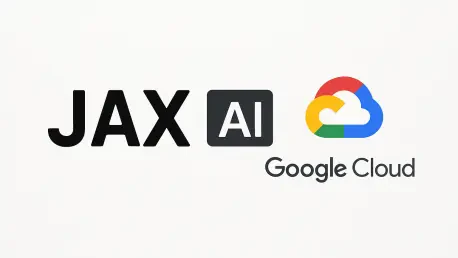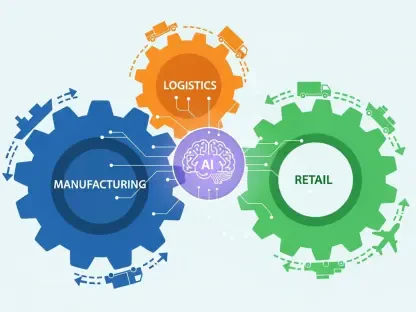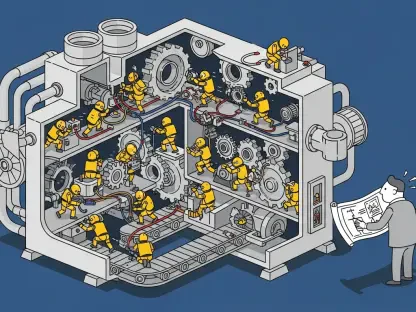Imagine a world where artificial intelligence development transcends traditional limitations, achieving speeds and scalability that once seemed out of reach for even the most ambitious projects. The JAX AI Stack, seamlessly integrated with Google Cloud Tensor Processing Units (TPUs), is turning this vision into reality for leading organizations like Anthropic, xAI, and Apple. This powerful synergy is not just enhancing research capabilities but also transforming production environments by enabling the creation of cutting-edge AI models with unmatched efficiency. Diving into this innovative ecosystem reveals how it addresses modern AI challenges with a unique blend of flexibility, raw power, and comprehensive support. This article explores the critical components, performance benefits, and real-world impacts of this platform, shedding light on why it stands as a cornerstone for the next generation of AI innovation.
Understanding the JAX AI Stack
Core Components and Functionality
The foundation of this transformative ecosystem lies in JAX, an open-source framework crafted for accelerator-driven numerical computation that redefines machine learning development. Unlike conventional frameworks that often impose rigid structures, JAX embraces a pure functional programming model, allowing for highly composable transformations that adapt effortlessly to various hardware setups. This design ensures that developers can focus on crafting algorithms without worrying about underlying hardware constraints. At its heart, JAX prioritizes scalability, making it an ideal choice for projects ranging from small experiments to large-scale industrial applications. Its ability to streamline complex computations into efficient processes sets a new benchmark for AI frameworks, providing a robust starting point for building sophisticated models with minimal overhead and maximum performance.
Complementing JAX are essential libraries like Flax and Optax, which significantly enhance the development experience by balancing simplicity with power. Flax offers an intuitive, object-oriented approach to neural network design, enabling developers to author models with familiar APIs while retaining the high-performance benefits of JAX. Meanwhile, Optax provides a suite of composable optimization algorithms, allowing for flexible chaining of techniques like Adam with advanced methods such as gradient clipping. Together, these libraries create a cohesive environment where rapid prototyping meets rigorous optimization, catering to a wide array of use cases. Their integration ensures that users can transition smoothly from conceptual ideas to functional implementations, all while leveraging the underlying efficiency of the broader ecosystem for consistent and reliable outcomes.
Modularity for Customization
One of the standout features of this AI stack is its modular architecture, designed to empower developers with unparalleled customization options tailored to specific project needs. Built on a collection of loosely coupled libraries, the system allows users to select tools for tasks like data loading, optimization, or model checkpointing without being tethered to a monolithic framework. This flexibility fosters an environment where innovation can flourish, as new techniques or libraries can be integrated without necessitating a complete overhaul of existing workflows. Such adaptability is crucial in a field where advancements occur at a rapid pace, ensuring that teams can stay ahead of the curve by adopting the latest methodologies with minimal disruption to their processes.
This modular approach also facilitates collaboration across diverse teams, as different components can be mixed and matched to suit varying expertise levels and project goals. For instance, researchers focused on quick iteration can leverage high-level abstractions to test hypotheses, while infrastructure engineers can dive into lower-level tools for fine-tuned performance adjustments. The result is a dynamic ecosystem that supports a spectrum of workflows, from experimental research to production-ready deployments. By prioritizing customization over rigidity, the stack ensures that every user can craft a development path that aligns with their unique requirements, ultimately driving efficiency and creativity in equal measure across the AI landscape.
Performance and Scalability on Google Cloud TPUs
Hardware Integration
The integration of JAX with Google Cloud TPUs represents a pivotal advancement in achieving peak AI performance, largely due to the innovative use of XLA (Accelerated Linear Algebra) as a compiler-first approach. XLA optimizes computations through whole-program analysis, enhancing memory layouts and reducing reliance on hand-written kernels, which often bottleneck traditional systems. This means that whether running a small test on a single accelerator or managing a sprawling cluster of thousands of TPUs, the system delivers consistent efficiency. The hardware-specific optimizations ensure that computational resources are utilized to their fullest potential, making it possible to tackle increasingly complex models without sacrificing speed or accuracy in the process.
Another key element in this integration is Pathways, a runtime designed for distributed computation that abstracts the complexity of managing large-scale clusters. Developers can write code as if working on a single machine, while Pathways handles the intricacies of scaling across thousands of chips with built-in fault tolerance. This abstraction is a game-changer for projects requiring massive computational power, as it eliminates the need for intricate manual configurations and mitigates risks associated with hardware failures. By streamlining distributed workflows, Pathways empowers teams to focus on innovation rather than infrastructure, ensuring that even the most ambitious AI initiatives can scale seamlessly with robust support for resilience and performance.
Real-World Impact
The tangible benefits of JAX and Google Cloud TPUs are vividly illustrated through real-world case studies that highlight their transformative potential across diverse applications. For instance, Kakao achieved a remarkable 2.7x increase in throughput for large language models, demonstrating how this platform can significantly enhance operational efficiency in production environments. Similarly, Lightricks successfully scaled a 13-billion-parameter generative video model with near-linear efficiency, showcasing the system’s ability to handle resource-intensive tasks without compromising on speed. These examples underscore the practical value of the ecosystem, proving that its performance capabilities translate directly into measurable gains for organizations tackling complex AI challenges.
Further evidence of impact comes from Escalante, which leveraged the stack’s composability to achieve a 3.65x better performance-per-dollar in AI-driven protein design for scientific research. This cost-performance optimization highlights another critical advantage: the ability to deliver high-quality results while managing budgets effectively. Such success stories span multiple industries, from tech giants refining language models to research entities pushing boundaries in computational biology. They collectively affirm that the integration of specialized hardware and software isn’t just a theoretical improvement but a proven solution that addresses real operational needs, setting a high standard for what AI platforms can achieve in practice.
End-to-End AI Development
Comprehensive Lifecycle Support
A defining strength of the JAX ecosystem is its comprehensive support for every phase of the machine learning lifecycle, ensuring a seamless journey from data preprocessing to production deployment. Libraries like Grain optimize data loading with performant, deterministic pipelines, while Tunix facilitates post-training model alignment using advanced algorithms such as SFT and DPO. For deployment, compatibility with solutions like vLLM ensures efficient model serving across various environments. This end-to-end approach means that developers aren’t just equipped to train models but are supported at every step, from raw data to real-world application, with tools specifically designed to maximize efficiency and reliability throughout the process.
Equally important is the balance between abstraction and control that the stack offers, catering to a wide range of users with differing priorities and expertise. High-level libraries provide ease of use for researchers who need to prototype quickly, enabling rapid iteration without deep technical overhead. Conversely, low-level tools like Pallas offer granular control for engineers focused on squeezing out every microsecond of performance in critical applications. This duality ensures that the platform remains accessible to newcomers while providing depth for seasoned professionals, creating an inclusive environment where diverse needs are met without compromise, and every stage of development benefits from tailored support.
Driving Innovation Across Industries
The versatility of JAX paired with Google Cloud TPUs is evident in its ability to empower a broad spectrum of applications, from commercial tech to academic research. Large language models, generative video frameworks, and scientific simulations are just a few areas where this platform excels, adapting to the unique demands of each domain with ease. Companies and institutions are finding that the stack not only handles the computational intensity of modern AI but also offers cost-performance benefits that make ambitious projects financially viable. This adaptability positions the ecosystem as a catalyst for breakthroughs, enabling teams to explore uncharted territories in AI without being constrained by technological or budgetary limitations.
Moreover, the platform’s impact extends beyond individual successes to influence broader industry trends, signaling a shift toward modular, hardware-accelerated frameworks. By addressing varied use cases with equal proficiency, it challenges the notion that AI development must be a one-size-fits-all endeavor. The ability to scale effortlessly while maintaining efficiency has inspired organizations to rethink their approach to model building, prioritizing flexibility and performance over outdated, monolithic systems. As more sectors adopt this technology, the ripple effects are likely to redefine standards for innovation, proving that a well-integrated stack can drive progress in ways that resonate far beyond isolated achievements.
Reflecting on Transformative Milestones
Looking back, the integration of JAX with Google Cloud TPUs marked a significant turning point in how AI models were developed and deployed at scale. Its modular architecture provided a refreshing departure from rigid frameworks, allowing countless developers to tailor solutions that met precise needs with remarkable precision. The scalability achieved through hardware optimization and tools like Pathways demonstrated that even the most complex projects could be managed with efficiency and resilience. Real-world outcomes, from boosted throughput to groundbreaking scientific applications, validated the platform’s promise, showing that it delivered on both performance and practicality across diverse fields.
As attention turned to future possibilities, the focus shifted toward expanding access to this ecosystem through resources like tutorials and detailed documentation. Exploring these materials became a logical next step for those eager to harness the stack’s capabilities for upcoming initiatives. The emphasis also rested on fostering collaboration, encouraging teams to share insights and build upon existing successes to tackle emerging challenges. By continuing to refine tools and broaden their applicability, the foundation was laid for sustained innovation, ensuring that the advancements achieved would serve as a springboard for even greater strides in AI development.









